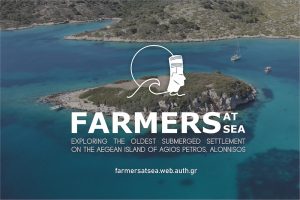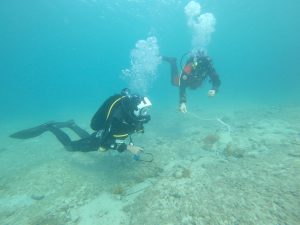D&D II - 8,000 Years Under the Sea - Agios Petros, Greece
 This week we head back 8000 years to the Neolithic in the Aegean Sea, where we learn that people in this period were far more advanced than they’re often given credit for.
This week we head back 8000 years to the Neolithic in the Aegean Sea, where we learn that people in this period were far more advanced than they’re often given credit for.
When we talk about maritime archaeology the first thing that comes to mind is shipwrecks, but here we explore something much bigger: submerged landscapes – prehistoric landscapes once occupied but now lying several metres underwater.
Bettany talks to the director from the site of Agios Petros, Nikos Efstratiou. Nikos and his team are working on the earliest submerged site found to date in the Aegean. Older than Homer and the Great Pyramids, this site contains evidence of a farming and fishing community now partially lost beneath the waves.
Finds including tuna bones and specialized fishing hooks have revealed that these – prehistoric people were capable of crossing open water and deep sea fishing, what really stands out in this episode is how connected and technologically advanced this community was.
Nikos and his team are still working at the site, and they’re about to start coring work, which will help them to study the sediments and better understand the process by which the village became submerged. Was it a gradual sea level rise, or was it something more dramatic caused by tectonic movements in the region?
They also hope to use the latest DNA techniques to extract information from the sediments about our ancient past, so watch this space!

Later in the episode, Lucy explores the concept of Neolithic seafaring in more depth with experts Panos Tzovaras and Helen Farr. Panos is building up an extensive database of all known images or models of Neolithic boats in the Aegean, whether depicted in ancient rock art or a carved stone model! This careful process of cataloguing and recording these images is highly scientific, but Panos is also discovering how symbolic boats were in this period.
The only thing we are missing is a full-size Neolithic boat. We are yet to discover one, but there is rich evidence of seafaring and trade. Lucy explores one particular material transported by ships – obsidian. This black volcanic glass is only formed in certain parts of the Mediterranean, yet we find it on many archaeological sites both here and beyond. People were travelling, and they were moving with this material. Perhaps for trade? Perhaps as a status symbol?
All this evidence demonstrates that people 8000 years ago were far more connected and advanced than we thought.
Thank you to Nikos, Panos and Helen for revealing more about our ancient past, and giving us a window into the daily lives of a Neolithic community.
Nikos Efrstratiou
Panos Tzovaras
Helen Farr
More information about the project at Agios Petros can be found here
